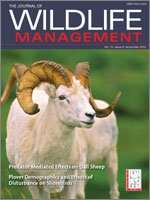Research into the use of predator-odor–based repellents as a management tool has gained momentum during the past 30 years. Some studies have suggested that odors from a predator whose diet includes the target species are more effective than odors from a predator that does not consume the species. To evaluate this management tool in the Australian context and to determine the effect, if any, of predator diet on odor repellence, we tested eutherian and metatherian, predator fecal odors on phylogenetically separated pest species that currently occur in Australia. We evaluated fecal odors from tigers (Panthera tigris) and Tasmanian devils (Sarcophilus harrisii) as repellents for goats (Capra hircus) and eastern grey kangaroos (Macropus giganteus). We fed tigers and Tasmanian devils 2 diets: one of goat and one of eastern grey kangaroo. The test fecal odors were more effective than a control odor of carrier material and solvent at deterring goats (P < 0.001) and kangaroos (P = 0.02) from food. Tiger fecal odor was more effective than Tasmanian devil odor in deterring both goats (P = 0.001) and kangaroos (P = 0.03). We observed a decrease in the number of feeding events for goats when they were exposed to the odor from a tiger fed goat compared with all other predator–diet combinations (P < 0.001). We also observed a decrease in feeding events for kangaroos when exposed to the odor from a tiger fed kangaroo compared with all other predator–diet combinations. We observed signs of desensitization to the test odors in goats and habituation to the test odors in kangaroos over the experimental period. A better understanding of the factors involved in desensitization and habituation may increase the effectiveness of fecal odor–based repellents as a humane and nonlethal management tool for managers.
How to translate text using browser tools
1 November 2010
Pest Responses to Odors From Predators Fed a Diet of Target Species Conspecifics and Heterospecifics
Tarnya E. Cox,
Peter J. Murray,
Graham P. Hall,
Xiuhua Li
ACCESS THE FULL ARTICLE
It is not available for individual sale.
This article is only available to subscribers.
It is not available for individual sale.
It is not available for individual sale.

Journal of Wildlife Management
Vol. 74 • No. 8
November 2010
Vol. 74 • No. 8
November 2010




